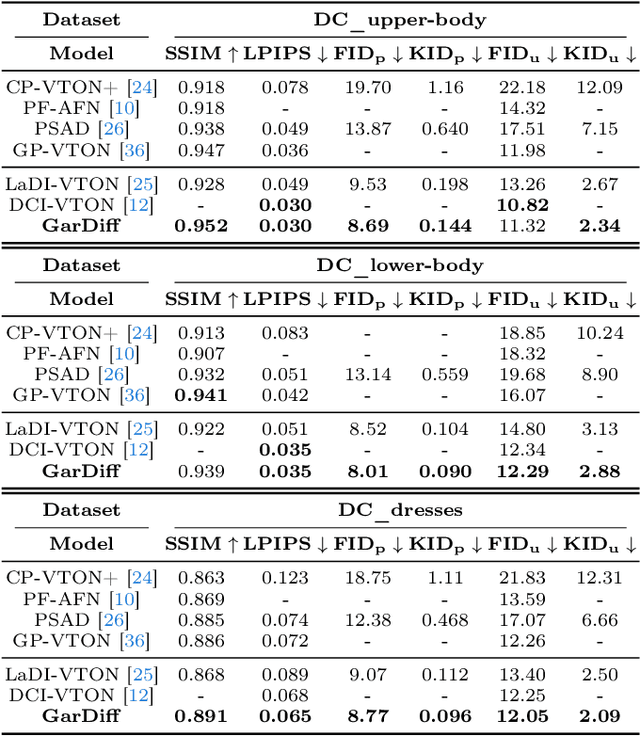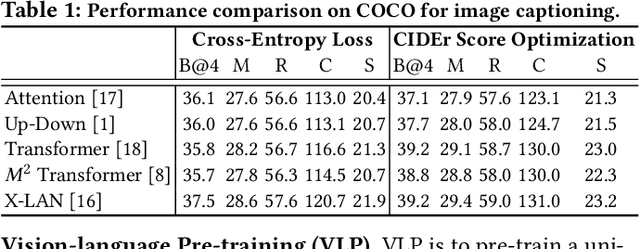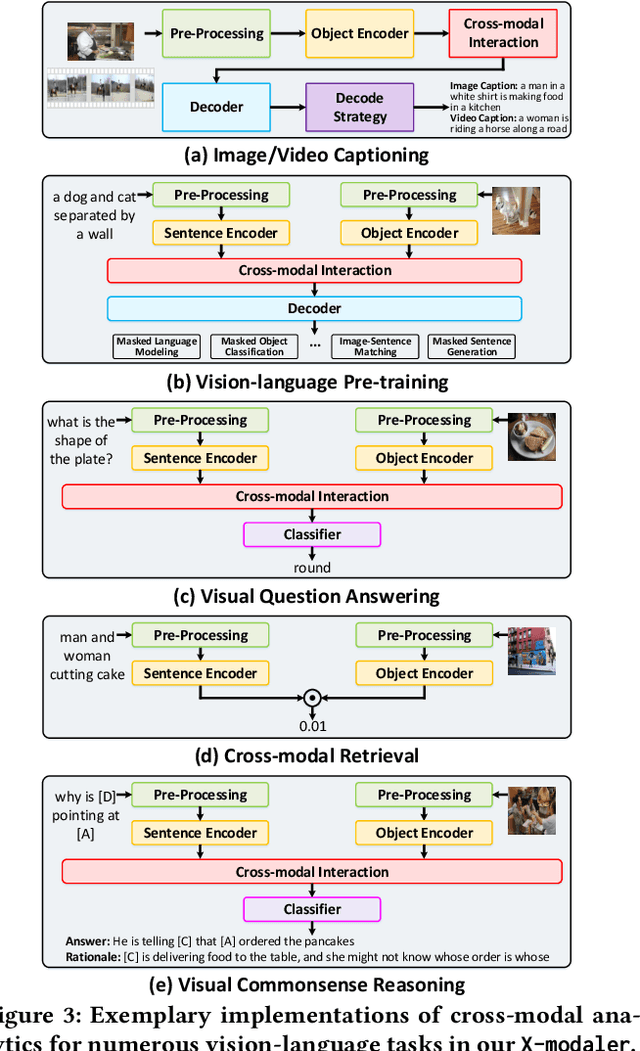Jingwen Chen
HiDream-I1: A High-Efficient Image Generative Foundation Model with Sparse Diffusion Transformer
May 28, 2025Abstract:Recent advancements in image generative foundation models have prioritized quality improvements but often at the cost of increased computational complexity and inference latency. To address this critical trade-off, we introduce HiDream-I1, a new open-source image generative foundation model with 17B parameters that achieves state-of-the-art image generation quality within seconds. HiDream-I1 is constructed with a new sparse Diffusion Transformer (DiT) structure. Specifically, it starts with a dual-stream decoupled design of sparse DiT with dynamic Mixture-of-Experts (MoE) architecture, in which two separate encoders are first involved to independently process image and text tokens. Then, a single-stream sparse DiT structure with dynamic MoE architecture is adopted to trigger multi-model interaction for image generation in a cost-efficient manner. To support flexiable accessibility with varied model capabilities, we provide HiDream-I1 in three variants: HiDream-I1-Full, HiDream-I1-Dev, and HiDream-I1-Fast. Furthermore, we go beyond the typical text-to-image generation and remould HiDream-I1 with additional image conditions to perform precise, instruction-based editing on given images, yielding a new instruction-based image editing model namely HiDream-E1. Ultimately, by integrating text-to-image generation and instruction-based image editing, HiDream-I1 evolves to form a comprehensive image agent (HiDream-A1) capable of fully interactive image creation and refinement. To accelerate multi-modal AIGC research, we have open-sourced all the codes and model weights of HiDream-I1-Full, HiDream-I1-Dev, HiDream-I1-Fast, HiDream-E1 through our project websites: https://github.com/HiDream-ai/HiDream-I1 and https://github.com/HiDream-ai/HiDream-E1. All features can be directly experienced via https://vivago.ai/studio.
Incorporating Visual Correspondence into Diffusion Model for Virtual Try-On
May 22, 2025



Abstract:Diffusion models have shown preliminary success in virtual try-on (VTON) task. The typical dual-branch architecture comprises two UNets for implicit garment deformation and synthesized image generation respectively, and has emerged as the recipe for VTON task. Nevertheless, the problem remains challenging to preserve the shape and every detail of the given garment due to the intrinsic stochasticity of diffusion model. To alleviate this issue, we novelly propose to explicitly capitalize on visual correspondence as the prior to tame diffusion process instead of simply feeding the whole garment into UNet as the appearance reference. Specifically, we interpret the fine-grained appearance and texture details as a set of structured semantic points, and match the semantic points rooted in garment to the ones over target person through local flow warping. Such 2D points are then augmented into 3D-aware cues with depth/normal map of target person. The correspondence mimics the way of putting clothing on human body and the 3D-aware cues act as semantic point matching to supervise diffusion model training. A point-focused diffusion loss is further devised to fully take the advantage of semantic point matching. Extensive experiments demonstrate strong garment detail preservation of our approach, evidenced by state-of-the-art VTON performances on both VITON-HD and DressCode datasets. Code is publicly available at: https://github.com/HiDream-ai/SPM-Diff.
DeepCritic: Deliberate Critique with Large Language Models
May 01, 2025Abstract:As Large Language Models (LLMs) are rapidly evolving, providing accurate feedback and scalable oversight on their outputs becomes an urgent and critical problem. Leveraging LLMs as critique models to achieve automated supervision is a promising solution. In this work, we focus on studying and enhancing the math critique ability of LLMs. Current LLM critics provide critiques that are too shallow and superficial on each step, leading to low judgment accuracy and struggling to offer sufficient feedback for the LLM generator to correct mistakes. To tackle this issue, we propose a novel and effective two-stage framework to develop LLM critics that are capable of deliberately critiquing on each reasoning step of math solutions. In the first stage, we utilize Qwen2.5-72B-Instruct to generate 4.5K long-form critiques as seed data for supervised fine-tuning. Each seed critique consists of deliberate step-wise critiques that includes multi-perspective verifications as well as in-depth critiques of initial critiques for each reasoning step. Then, we perform reinforcement learning on the fine-tuned model with either existing human-labeled data from PRM800K or our automatically annotated data obtained via Monte Carlo sampling-based correctness estimation, to further incentivize its critique ability. Our developed critique model built on Qwen2.5-7B-Instruct not only significantly outperforms existing LLM critics (including the same-sized DeepSeek-R1-distill models and GPT-4o) on various error identification benchmarks, but also more effectively helps the LLM generator refine erroneous steps through more detailed feedback.
Beyond Wide-Angle Images: Unsupervised Video Portrait Correction via Spatiotemporal Diffusion Adaptation
Apr 01, 2025Abstract:Wide-angle cameras, despite their popularity for content creation, suffer from distortion-induced facial stretching-especially at the edge of the lens-which degrades visual appeal. To address this issue, we propose an image portrait correction framework using diffusion models named ImagePD. It integrates the long-range awareness of transformer and multi-step denoising of diffusion models into a unified framework, achieving global structural robustness and local detail refinement. Besides, considering the high cost of obtaining video labels, we then repurpose ImagePD for unlabeled wide-angle videos (termed VideoPD), by spatiotemporal diffusion adaption with spatial consistency and temporal smoothness constraints. For the former, we encourage the denoised image to approximate pseudo labels following the wide-angle distortion distribution pattern, while for the latter, we derive rectification trajectories with backward optical flows and smooth them. Compared with ImagePD, VideoPD maintains high-quality facial corrections in space and mitigates the potential temporal shakes sequentially. Finally, to establish an evaluation benchmark and train the framework, we establish a video portrait dataset with a large diversity in people number, lighting conditions, and background. Experiments demonstrate that the proposed methods outperform existing solutions quantitatively and qualitatively, contributing to high-fidelity wide-angle videos with stable and natural portraits. The codes and dataset will be available.
Unleashing Text-to-Image Diffusion Prior for Zero-Shot Image Captioning
Dec 31, 2024Abstract:Recently, zero-shot image captioning has gained increasing attention, where only text data is available for training. The remarkable progress in text-to-image diffusion model presents the potential to resolve this task by employing synthetic image-caption pairs generated by this pre-trained prior. Nonetheless, the defective details in the salient regions of the synthetic images introduce semantic misalignment between the synthetic image and text, leading to compromised results. To address this challenge, we propose a novel Patch-wise Cross-modal feature Mix-up (PCM) mechanism to adaptively mitigate the unfaithful contents in a fine-grained manner during training, which can be integrated into most of encoder-decoder frameworks, introducing our PCM-Net. Specifically, for each input image, salient visual concepts in the image are first detected considering the image-text similarity in CLIP space. Next, the patch-wise visual features of the input image are selectively fused with the textual features of the salient visual concepts, leading to a mixed-up feature map with less defective content. Finally, a visual-semantic encoder is exploited to refine the derived feature map, which is further incorporated into the sentence decoder for caption generation. Additionally, to facilitate the model training with synthetic data, a novel CLIP-weighted cross-entropy loss is devised to prioritize the high-quality image-text pairs over the low-quality counterparts. Extensive experiments on MSCOCO and Flickr30k datasets demonstrate the superiority of our PCM-Net compared with state-of-the-art VLMs-based approaches. It is noteworthy that our PCM-Net ranks first in both in-domain and cross-domain zero-shot image captioning. The synthetic dataset SynthImgCap and code are available at https://jianjieluo.github.io/SynthImgCap.
Improving Text-guided Object Inpainting with Semantic Pre-inpainting
Sep 12, 2024Abstract:Recent years have witnessed the success of large text-to-image diffusion models and their remarkable potential to generate high-quality images. The further pursuit of enhancing the editability of images has sparked significant interest in the downstream task of inpainting a novel object described by a text prompt within a designated region in the image. Nevertheless, the problem is not trivial from two aspects: 1) Solely relying on one single U-Net to align text prompt and visual object across all the denoising timesteps is insufficient to generate desired objects; 2) The controllability of object generation is not guaranteed in the intricate sampling space of diffusion model. In this paper, we propose to decompose the typical single-stage object inpainting into two cascaded processes: 1) semantic pre-inpainting that infers the semantic features of desired objects in a multi-modal feature space; 2) high-fieldity object generation in diffusion latent space that pivots on such inpainted semantic features. To achieve this, we cascade a Transformer-based semantic inpainter and an object inpainting diffusion model, leading to a novel CAscaded Transformer-Diffusion (CAT-Diffusion) framework for text-guided object inpainting. Technically, the semantic inpainter is trained to predict the semantic features of the target object conditioning on unmasked context and text prompt. The outputs of the semantic inpainter then act as the informative visual prompts to guide high-fieldity object generation through a reference adapter layer, leading to controllable object inpainting. Extensive evaluations on OpenImages-V6 and MSCOCO validate the superiority of CAT-Diffusion against the state-of-the-art methods. Code is available at \url{https://github.com/Nnn-s/CATdiffusion}.
Improving Virtual Try-On with Garment-focused Diffusion Models
Sep 12, 2024



Abstract:Diffusion models have led to the revolutionizing of generative modeling in numerous image synthesis tasks. Nevertheless, it is not trivial to directly apply diffusion models for synthesizing an image of a target person wearing a given in-shop garment, i.e., image-based virtual try-on (VTON) task. The difficulty originates from the aspect that the diffusion process should not only produce holistically high-fidelity photorealistic image of the target person, but also locally preserve every appearance and texture detail of the given garment. To address this, we shape a new Diffusion model, namely GarDiff, which triggers the garment-focused diffusion process with amplified guidance of both basic visual appearance and detailed textures (i.e., high-frequency details) derived from the given garment. GarDiff first remoulds a pre-trained latent diffusion model with additional appearance priors derived from the CLIP and VAE encodings of the reference garment. Meanwhile, a novel garment-focused adapter is integrated into the UNet of diffusion model, pursuing local fine-grained alignment with the visual appearance of reference garment and human pose. We specifically design an appearance loss over the synthesized garment to enhance the crucial, high-frequency details. Extensive experiments on VITON-HD and DressCode datasets demonstrate the superiority of our GarDiff when compared to state-of-the-art VTON approaches. Code is publicly available at: \href{https://github.com/siqi0905/GarDiff/tree/master}{https://github.com/siqi0905/GarDiff/tree/master}.
ControlStyle: Text-Driven Stylized Image Generation Using Diffusion Priors
Nov 09, 2023



Abstract:Recently, the multimedia community has witnessed the rise of diffusion models trained on large-scale multi-modal data for visual content creation, particularly in the field of text-to-image generation. In this paper, we propose a new task for ``stylizing'' text-to-image models, namely text-driven stylized image generation, that further enhances editability in content creation. Given input text prompt and style image, this task aims to produce stylized images which are both semantically relevant to input text prompt and meanwhile aligned with the style image in style. To achieve this, we present a new diffusion model (ControlStyle) via upgrading a pre-trained text-to-image model with a trainable modulation network enabling more conditions of text prompts and style images. Moreover, diffusion style and content regularizations are simultaneously introduced to facilitate the learning of this modulation network with these diffusion priors, pursuing high-quality stylized text-to-image generation. Extensive experiments demonstrate the effectiveness of our ControlStyle in producing more visually pleasing and artistic results, surpassing a simple combination of text-to-image model and conventional style transfer techniques.
X-modaler: A Versatile and High-performance Codebase for Cross-modal Analytics
Aug 18, 2021



Abstract:With the rise and development of deep learning over the past decade, there has been a steady momentum of innovation and breakthroughs that convincingly push the state-of-the-art of cross-modal analytics between vision and language in multimedia field. Nevertheless, there has not been an open-source codebase in support of training and deploying numerous neural network models for cross-modal analytics in a unified and modular fashion. In this work, we propose X-modaler -- a versatile and high-performance codebase that encapsulates the state-of-the-art cross-modal analytics into several general-purpose stages (e.g., pre-processing, encoder, cross-modal interaction, decoder, and decode strategy). Each stage is empowered with the functionality that covers a series of modules widely adopted in state-of-the-arts and allows seamless switching in between. This way naturally enables a flexible implementation of state-of-the-art algorithms for image captioning, video captioning, and vision-language pre-training, aiming to facilitate the rapid development of research community. Meanwhile, since the effective modular designs in several stages (e.g., cross-modal interaction) are shared across different vision-language tasks, X-modaler can be simply extended to power startup prototypes for other tasks in cross-modal analytics, including visual question answering, visual commonsense reasoning, and cross-modal retrieval. X-modaler is an Apache-licensed codebase, and its source codes, sample projects and pre-trained models are available on-line: https://github.com/YehLi/xmodaler.
Scheduled Sampling in Vision-Language Pretraining with Decoupled Encoder-Decoder Network
Jan 27, 2021



Abstract:Despite having impressive vision-language (VL) pretraining with BERT-based encoder for VL understanding, the pretraining of a universal encoder-decoder for both VL understanding and generation remains challenging. The difficulty originates from the inherently different peculiarities of the two disciplines, e.g., VL understanding tasks capitalize on the unrestricted message passing across modalities, while generation tasks only employ visual-to-textual message passing. In this paper, we start with a two-stream decoupled design of encoder-decoder structure, in which two decoupled cross-modal encoder and decoder are involved to separately perform each type of proxy tasks, for simultaneous VL understanding and generation pretraining. Moreover, for VL pretraining, the dominant way is to replace some input visual/word tokens with mask tokens and enforce the multi-modal encoder/decoder to reconstruct the original tokens, but no mask token is involved when fine-tuning on downstream tasks. As an alternative, we propose a primary scheduled sampling strategy that elegantly mitigates such discrepancy via pretraining encoder-decoder in a two-pass manner. Extensive experiments demonstrate the compelling generalizability of our pretrained encoder-decoder by fine-tuning on four VL understanding and generation downstream tasks. Source code is available at \url{https://github.com/YehLi/TDEN}.
 Add to Chrome
Add to Chrome Add to Firefox
Add to Firefox Add to Edge
Add to Edge